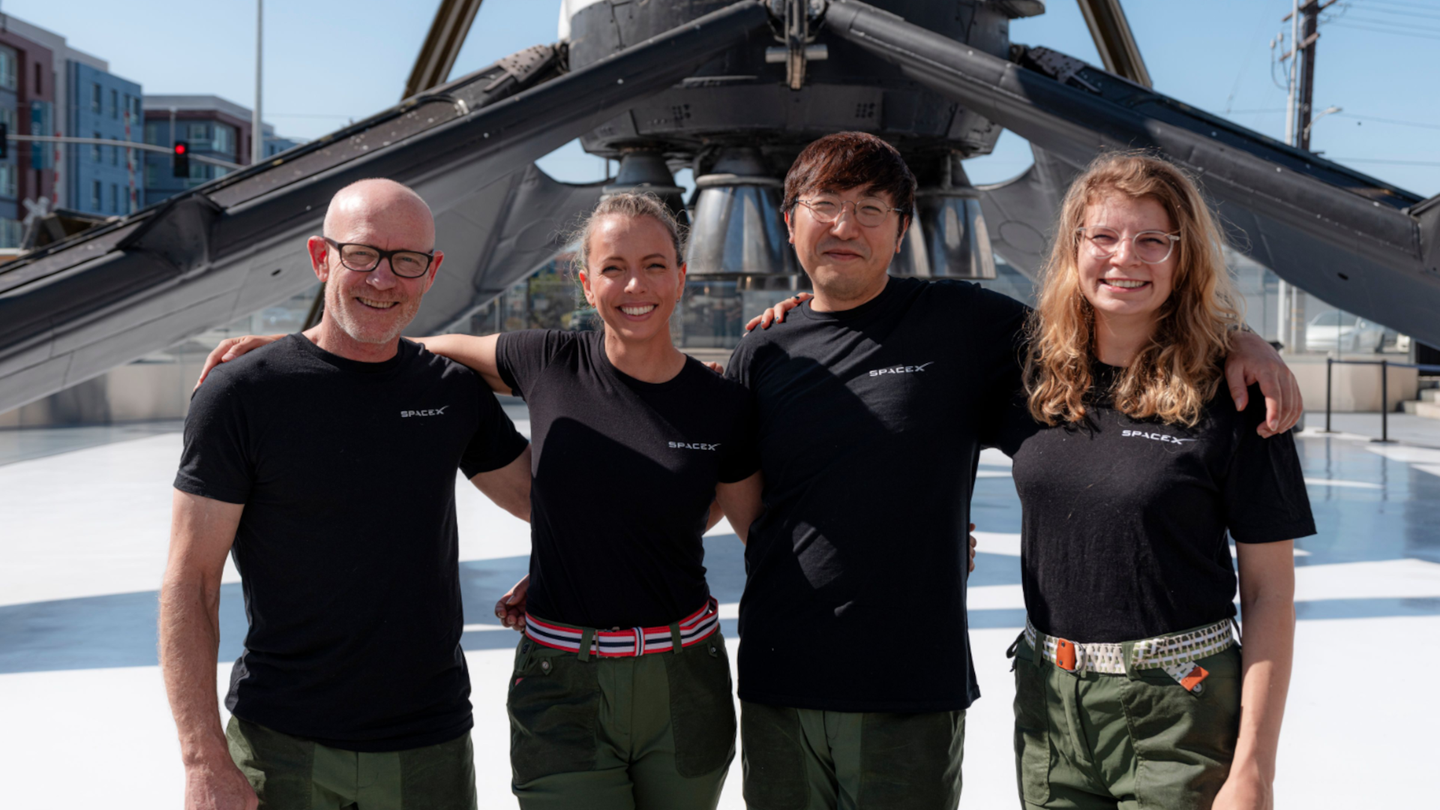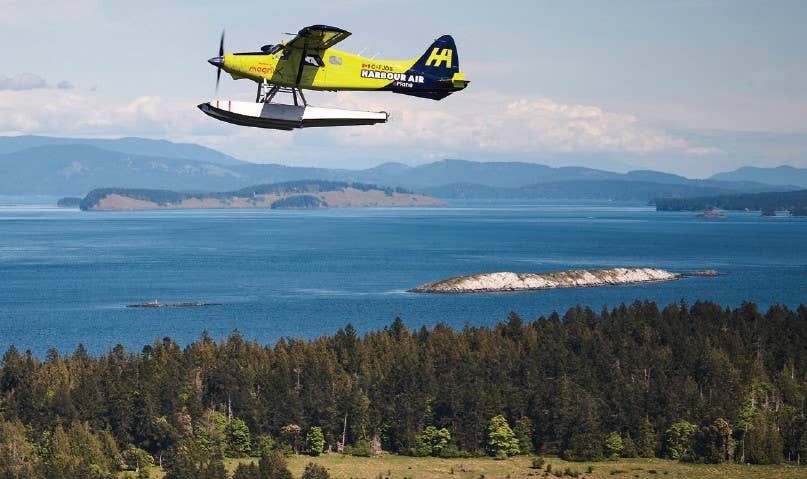SpaceX Unveils Historic Polar Orbit Mission Backed by Crypto Magnate
Four astronauts will travel to the ends of the Earth on the Fram2 mission, flown by SpaceX on behalf of Bitcoin entrepreneur Chun Wang.

The crew of SpaceX’s newly announced Fram2 mission—Eric Philips (from left), Jannicke Mikkelsen, Chun Wang, and Rabea Rogge—will view Earth’s poles from orbit for the first time. [Courtesy: SpaceX]
A crypto entrepreneur, a cinematographer, a polar adventurer, and a robotics expert walk into a SpaceX Crew Dragon.
That’s not the beginning of a bad joke, but rather a description of SpaceX’s newly announced human spaceflight mission, which as soon as this year will send four astronauts to the ends of the Earth for the first time in history.
The company on Monday unveiled Fram2—a mission to explore the planet’s polar regions, over which no spacecraft has ever flown directly. During the three-to-five-day mission, which will launch from Florida atop SpaceX’s Falcon 9 rocket, the crew will enter a 90-degree polar orbit and observe the Arctic and Antarctic wilderness through a cupola fitted to the company’s Dragon capsule.
No crewed spacecraft has ever reached an orbital path higher than 65 degrees, a feat the Soviet Vostok 6 mission, which carried the first woman to space, achieved in 1963. Typically, such orbits are occupied by smaller satellites, while larger spacecraft such as the International Space Station fly closer to the equator.
The expedition, named after the ship Fram used by Norwegian explorers to reach the poles in the late 19th century, will be Dragon’s sixth commercial astronaut mission and third free-flying mission. The spacecraft has flown three private missions to the ISS for customer Axiom Space, completed the Inspiration4 private orbital spaceflight on behalf of billionaire entrepreneur Jared Isaacman, and will launch another mission for Isaacman—Polaris Dawn—as soon as this month.
“Polaris Program, Inspiration4, Axiom, & now Fram2 showcase what commercial missions can achieve thanks to @SpaceX's reusability and NASA's vision with the commercial crew program,” Isaacman said in a post on social media platform X, which is owned by SpaceX CEO Elon Musk. “All just small steps towards unlocking the last great frontier.”
Fram2 similarly is backed by a wealthy CEO, entrepreneur and adventurer Chun Wang, who made his fortune from Bitcoin mining. Wang purchased the mission for an undisclosed amount and will serve as commander.
According to his profile on X, Wang is an avid traveler who has visited half of the world’s countries and territories. But he has grander aspirations.
“I’ve read many sci-fi stories about the first human missions to Mars, usually led by NASA or some fictional government,” Wang said in a post on X. “Rarely does anyone dare to imagine such a mission may be carried out privately. But now, I increasingly believe that someday we will reach Mars—and it may be a person, or a company, not a nation, who gets there.”
Accompanying Wang will be commander Jannicke Mikkelsen of Norway, pilot Eric Philips of Australia, and mission specialist Rabea Rogge of Germany, who told the website Everyday Astronaut they befriended the blockchain entrepreneur on a trek to the North Pole. All four crew members will be making their first trip to the final frontier.
Mikkelson is a filmmaker who seeks out remote or hazardous filming locations and served as payload specialist on the 2019 One More Orbit mission—a record-breaking polar circumnavigation flight on the 50th anniversary of Apollo 11.
According to its website, Fram2 will shatter One More Orbit’s high water mark of 46 hours and 40 minutes, achieved in a Qatar Executive Gulfstream G650ER ultra-long-range business jet, by flying from the north to south pole in just 46 minutes.
Philips, a polar adventurer and guide, knows those regions well, having completed several ski expeditions. But viewing them from orbit has never been possible, even for astronauts on the ISS, to whom they appear invisible.
Fram2 will orbit at about 264-280 miles above Earth, allowing the crew to study strange green and purple light emissions known as Strong Thermal Emission Velocity Enhancements (STEVE), atmospheric phenomena that resemble auroras. Researchers have yet to determine what causes the optical abnormalities. The mission will weigh input from space physicists and citizen scientists alike.
“Having spent much of my adult life in the polar regions this is an incredible opportunity to view the Arctic and Antarctica from space, in particular Antarctica which will be fully lit at this time of year,” said Philips.
Rogge similarly has a fascination with extreme environments, having researched ocean robotics in the Arctic in pursuit of ways to improve the technology. She will get the chance to study tools that could prepare humans for future missions to Mars and beyond, “from capturing the first human x-ray images in space to Just-in-Time training tools to the effects of spaceflight on behavioral health,” according to Fram2’s webpage. The crew will also study what happens to the human body after weeks or months in space.
“Wang aims to use the mission to highlight the crew’s explorational spirit, bring a sense of wonder and curiosity to the larger public, and highlight how technology can help push the boundaries of exploration of Earth and through the mission’s research,” SpaceX said in an update on its website.
Since 2020, SpaceX has flown 50 astronauts to low-Earth orbit across 13 human spaceflight missions, more than any private company. These include the three Axiom Space missions, Inspiration4, and eight NASA Commercial Crew rotation missions to the ISS, as well as the Demo-2 test flight.
Competitors Blue Origin and Virgin Galactic, meanwhile, have each completed seven commercial human spaceflights.
All three companies, in addition to NASA contractors such as Boeing and Northrop Grumman, are part of an emerging trend that could soon become the norm. NASA has predicted that when the ISS is retired at the end of the decade, it could become one of many customers enlisting the services of private spaceflight companies, rather than a provider of those services.
That could mean more private astronaut missions financed by millionaire and billionaire backers.
Like this story? We think you'll also like the Future of FLYING newsletter sent every Thursday afternoon. Sign up now.

Subscribe to Our Newsletter
Get the latest FLYING stories delivered directly to your inbox






